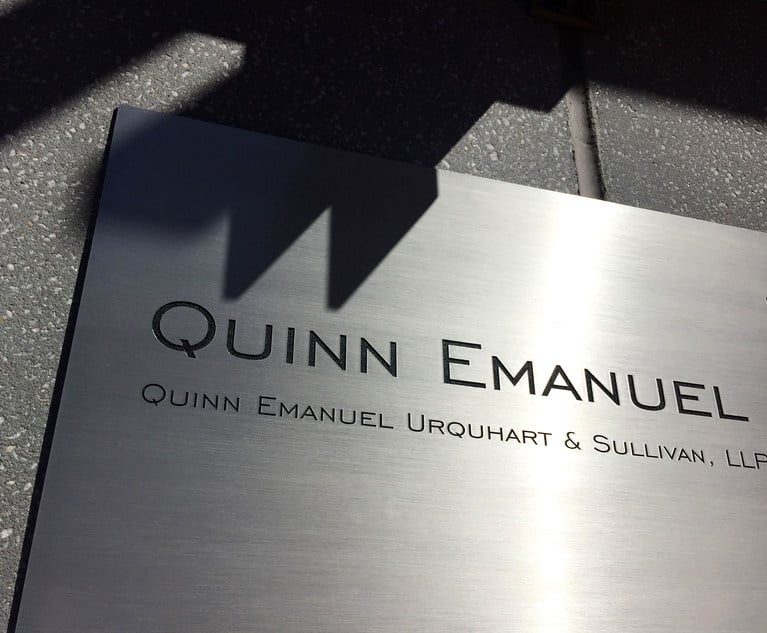AFAs Are an Option, but Mid-Market Law Firms Still Must Reckon With the Billable Hour
The billable hour can give mid-market firms an advantage when competing against Big Law because of the lower hourly rates, but not so when up against their peers. Moving away from it can be profitable for certain matters. But there are risks too.
September 06, 2019 at 05:00 PM
7 minute read
The original version of this story was published on Law.com
 istock
istock
Editor's Note: This story is adapted from ALM's Mid-Market Report. For more business of law coverage exclusively geared toward midsize firms, sign up for a free trial subscription to ALM's weekly newsletter, The Mid-Market Report.
The billable hour gets knocked around, criticised, its death predicted, only to continue on, and while the discussion of doing away with it usually centres on large law firms, it's a subject mid-market firms need to wrestle with too.
Should midsize firms move away from the billable hour? Given how diverse the mid-market and its client base are, it's not surprising that when talking to firm leaders or consultants, there's no clear consensus.
But in a highly competitive legal market, everything is on the table, even if many managing partners are quick to say: "It's not going anywhere." And there are clearly advantages – and potential dangers – to changing.
The advantage… and the trap
One of the things that complicates things for mid-market firms – and can be an incentive to stick with the billable hour – is the comparison of their hourly billing rates against large law firms, which can show a very stark value proposition.
Courtney Paulk, president of Hirschler, a 77-lawyer firm based in Richmond, Virginia, said her firm's lower hourly rate helps it to go after work pursued by big firms.
"Given our cost structure, Hirschler's hourly rates are consistently lower than our large firm competitors; standing toe-to-toe on talent, this pricing advantage allows us to compete effectively for sophisticated work," Paulk wrote in an email in response to questions.
Legal consultant Marcie Borgal Shunk, president and founder of the Tilt Institute, said midsize firms absolutely use the price difference to their advantage.
If firms can say: "I'm this calibre of lawyer and you get me at $600 an hour versus $1,200 an hour," Shunk said, that can be a powerful statement.
Patrick Fuller, vice-president of ALM Intelligence (a division of ALM, which also owns the Mid-Market Report), said that while many mid-market firms use the billable hour as an advantage, it does have its drawbacks.
"It can also work against firms, as the mindset that 'they aren't very expensive, so they may not be as good', does still exist," Fuller wrote in an email.
But because mid-market firms are often competing with similar-sized peers as well as Am Law 200 firms, it can be tricky – something that James Goodnow, president and managing partner of Fennemore Craig, a 190-lawyer-plus Mountain West firm based in Arizona, pointed out.
"The billable hour is a double-edged sword for mid-market firms," Goodnow wrote in an email. "A typical mid-market firm will have average rates that are significantly lower than an Am Law 100 firm, but mid-market firms are not always competing against Big Law; they are often competing against other mid-market firms or smaller boutique firms with rates that are just as low if not lower. So, mid-market firms better offer more than lower rates if they want to land new business."
Paulk echoed those sentiments.
"Mid-market firms like Hirschler enjoy the same advantage; competing with these peers, we must differentiate ourselves on more than price," she wrote. "The value we offer comes from our commitment to offering legal excellence with business efficiency."
Joel Carpenter, the managing partner of Sullivan & Worcester, a 136-lawyer firm based in Boston, said that while his firm's rates provide an advantage when competing against Big Law, it isn't a gigantic discount.
"The real advantage," he said, is in the billing – the hours and the efficiency.
"We're a bigger billing advantage," he said. "When we're competing against Big Law, we might have a rate advantage of charging 85% of what their rate is, but our bill is 60% of their bill.
"We don't have the same leverage. We're more efficient, so our billing hours are substantially lower. We see it and we articulate it."
He said that when it comes to competing against other mid-market firms, "we compete more on sophistication".
If you're always competing on price, it's "a race to the bottom", Carpenter said.
Move away from the billable hour?
When asked if mid-market firms should move away from the billable hour, Shunk said: "Yes and no."
Many mid-market clients aren't demanding alternative fee arrangements, though larger clients are, she said.
But there are clear advantages for midsize firms that can do work other than via the billable hour, she said.
"If you can handle the high-volume work under an AFA, you can increase profitability," she said, because you're essentially repeating processes. "If you're delivering efficiently, you can increase profitability."
Goodnow had a stronger view of the need for midsize firms to experiment with fee arrangements other than the billable hour.
"Mid-market firms need to be aggressive about using alternative fee arrangements, but only if they have the tools to price them correctly," he wrote. "Firms will lose their shirt if they price flat rates, blended rates, contingent fees, or other alternative fees, without understanding the cost of producing the services."
Fuller said there are many factors to consider when looking at whether mid-market firms should move away from the billable hour.
He said it was a tough question, with no definitive answer. Some practice areas and matters "are more conducive to the various alternative fee arrangements", he said.
Fuller said firms need to look at their internal structures when considering the issue.
"The attorney compensation structure of the firm is often an issue that needs to adjusted," Fuller wrote in an email. "Leverage and timekeeper resources are a factor as well, and in some instances, so are the outside counsel guidelines and the level of enforcement by each client.
"Ultimately, many buyers of legal services are looking for consistency and predictability with regard to their outside counsel fees."
Carpenter sounded sceptical about firms doing away with the billable hour.
"Everybody talks about it, but nobody actually does it," he said.
But that doesn't mean his firm doesn't use AFAs. Carpenter did say that his firm is accepting more contingency work, mostly in litigation.
"When a client raises AFAs, they're looking to get the work done at a lower rate," he said. "[General counsel] are working towards a budget, driven by internal pressures [and they need predictability].
"How do you balance that? Depends on the circumstances. In the best AFAs, you share some risk and some benefits."
Paulk pointed out that the variety of clients mid-market firms have is a factor.
"Mid-market firms tend to serve a broader range of clients in terms of size and sophistication, making a 'one-size' approach to pricing less practical – if not impossible," she wrote. "Client comfort plays a significant role in pricing and, in our experience, many mid-market clients are more at ease with the traditional model.
"For both the client and the firm, alternative fees arrangements are most successful where the scope or volume of work is both predictable and well defined."
This content has been archived. It is available through our partners, LexisNexis® and Bloomberg Law.
To view this content, please continue to their sites.
Not a Lexis Subscriber?
Subscribe Now
Not a Bloomberg Law Subscriber?
Subscribe Now
NOT FOR REPRINT
© 2025 ALM Global, LLC, All Rights Reserved. Request academic re-use from www.copyright.com. All other uses, submit a request to [email protected]. For more information visit Asset & Logo Licensing.
You Might Like
View All
X Ordered to Release Data by German Court Amid Election Interference Concerns

Compliance With the EU's AI Act Lags Behind as First Provisions Take Effect

Quinn Emanuel's Hamburg Managing Partner and Four-Lawyer Team Jump to Willkie Farr

Trump ICC Sanctions Condemned as ‘Brazen Attack’ on International Law
Trending Stories
- 1Ex-Starbucks GC Exiting Latest Role, Will Get Severance
- 2Family Law Special Section 2025
- 3We Must Uphold the Rights of Immigrant Students
- 4Orrick Picks Up 13-Lawyer Tech, VC Group From Gunderson Dettmer
- 5How Alzheimer’s and Other Cognitive Diseases Affect Guardianship, POAs and Estate Planning
Who Got The Work
J. Brugh Lower of Gibbons has entered an appearance for industrial equipment supplier Devco Corporation in a pending trademark infringement lawsuit. The suit, accusing the defendant of selling knock-off Graco products, was filed Dec. 18 in New Jersey District Court by Rivkin Radler on behalf of Graco Inc. and Graco Minnesota. The case, assigned to U.S. District Judge Zahid N. Quraishi, is 3:24-cv-11294, Graco Inc. et al v. Devco Corporation.
Who Got The Work
Rebecca Maller-Stein and Kent A. Yalowitz of Arnold & Porter Kaye Scholer have entered their appearances for Hanaco Venture Capital and its executives, Lior Prosor and David Frankel, in a pending securities lawsuit. The action, filed on Dec. 24 in New York Southern District Court by Zell, Aron & Co. on behalf of Goldeneye Advisors, accuses the defendants of negligently and fraudulently managing the plaintiff's $1 million investment. The case, assigned to U.S. District Judge Vernon S. Broderick, is 1:24-cv-09918, Goldeneye Advisors, LLC v. Hanaco Venture Capital, Ltd. et al.
Who Got The Work
Attorneys from A&O Shearman has stepped in as defense counsel for Toronto-Dominion Bank and other defendants in a pending securities class action. The suit, filed Dec. 11 in New York Southern District Court by Bleichmar Fonti & Auld, accuses the defendants of concealing the bank's 'pervasive' deficiencies in regards to its compliance with the Bank Secrecy Act and the quality of its anti-money laundering controls. The case, assigned to U.S. District Judge Arun Subramanian, is 1:24-cv-09445, Gonzalez v. The Toronto-Dominion Bank et al.
Who Got The Work
Crown Castle International, a Pennsylvania company providing shared communications infrastructure, has turned to Luke D. Wolf of Gordon Rees Scully Mansukhani to fend off a pending breach-of-contract lawsuit. The court action, filed Nov. 25 in Michigan Eastern District Court by Hooper Hathaway PC on behalf of The Town Residences LLC, accuses Crown Castle of failing to transfer approximately $30,000 in utility payments from T-Mobile in breach of a roof-top lease and assignment agreement. The case, assigned to U.S. District Judge Susan K. Declercq, is 2:24-cv-13131, The Town Residences LLC v. T-Mobile US, Inc. et al.
Who Got The Work
Wilfred P. Coronato and Daniel M. Schwartz of McCarter & English have stepped in as defense counsel to Electrolux Home Products Inc. in a pending product liability lawsuit. The court action, filed Nov. 26 in New York Eastern District Court by Poulos Lopiccolo PC and Nagel Rice LLP on behalf of David Stern, alleges that the defendant's refrigerators’ drawers and shelving repeatedly break and fall apart within months after purchase. The case, assigned to U.S. District Judge Joan M. Azrack, is 2:24-cv-08204, Stern v. Electrolux Home Products, Inc.
Featured Firms
Law Offices of Gary Martin Hays & Associates, P.C.
(470) 294-1674
Law Offices of Mark E. Salomone
(857) 444-6468
Smith & Hassler
(713) 739-1250








